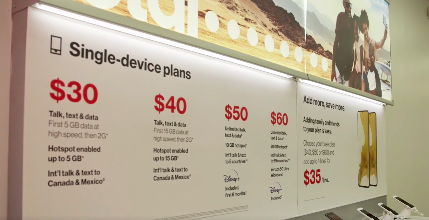Verizon is making an advertising push in prepaid, accompanied by a branding overhaul for its Total Wireless prepaid service that is now known as Total by Verizon.
The carrier has struggled with customer acquisition in recent quarters, and has been adjusting its pricing strategy in response—first with a new “Welcome” plan at a cost of $30 a month when customers brought four lines and their own devices—and now with a revamping of its prepaid positioning.
In the second quarter, Verizon’s consumer segment posted a net loss of 215,000 wireless retail postpaid phone net losses, with its overall net add number saved by 227,000 postpaid phone net additions from its business segment. The carrier also saw a similarly rough first quarter, posting phone net losses on weak gross adds, which continues to be a problem in a very competitive market were price is becoming more and more important to consumers as they are impacted by inflation. CEO Hans Vestberg recently said at a Goldman Sachs conference that analysts should expect negative—but improved—customer net phone additions in the consumer segment when Verizon reports its third-quarter numbers in late October; he cited seasonal fluctuations and the impacts of upward price adjustments on some plans, but added that stores are seeing increased traffic and that he expected churn to return to “business as usual” in the fourth quarter.
He repeatedly emphasized that Verizon would be “surgical, all the time, when it comes to price changes [and] new plans.”
With the Total by Verizon launch, Vestberg tweeted:
A press release touted Total by Verizon as a “disruptor in the prepaid industry”, saying that it has “some of the most compelling plan perks and benefits including 5G … network coverage, generous hotspot allocations, unlimited talk, text and data, and offers for Disney+.” The service’s plans start at $30 a month, with additional offerings at $40, $50 and $60 per month. The $60 per-month plan includes a Disney+ subscription, 5G access and unlimited talk, text and data use, plus 20 GB of hotspot data and international talk and texting to 69 countries.
The previous green color scheme for Total Wireless has been replaced with Verizon red, tying the prepaid offering closer both in name and design to Verizon branding.
“Total by Verizon represents our strategy to serve the entire market with a portfolio of brands that match every customer’s need, no matter where they are,” said Manon Brouillette, EVP and CEO of Verizon’s Consumer Group. “The unmatched distribution along with our unparalleled network and incredible plan perks will disrupt the prepaid market and speak directly to the broad value-conscious segment and their unique preferences.”
Total by Verizon may be the new brand, but it hasn’t taken over the Tracfone brand—at least at this point. The acquisition of Tracfone brought the largest U.S. wireless reseller under Verizon’s umbrella; it served about 20 million customers at the time of acquisition, about 13 million of which were using Verizon’s network through an existing wholesale agreement. Tracfone’s products are available in more than 90,000 retail locations across the U.S., and the company operates a number of subsidiary brands including StraightTalk, Total Wireless, Walmart Family Mobile, NET10 Wireless, SIMPLE Mobile and others.
In a Verizon video on the launch of the brand, Tracfone President Eduardo Corona said the launch was a “paramount moment” and that the Total by Verizon brand “represents the best of both Verizon and Tracfone.” He discussed Total by Verizon as a “premium option” for value-conscious customers that allows Tracfone to “elevate the non-contract experience.”
Angie Klein, chief revenue officer for Tracfone, was also featured in the video and said that in the coming weeks, Total by Verizon’s products and plans will be available at 50,000 retail locations including Walmart, Target and Dollar General.

